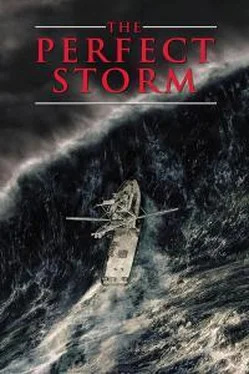Sebastian Junger - The Perfect Storm
Здесь есть возможность читать онлайн «Sebastian Junger - The Perfect Storm» — ознакомительный отрывок электронной книги совершенно бесплатно, а после прочтения отрывка купить полную версию. В некоторых случаях можно слушать аудио, скачать через торрент в формате fb2 и присутствует краткое содержание. Жанр: Триллер, Проза. Описание произведения, (предисловие) а так же отзывы посетителей доступны на портале библиотеки ЛибКат.
- Название:The Perfect Storm
- Автор:
- Жанр:
- Год:неизвестен
- ISBN:нет данных
- Рейтинг книги:3 / 5. Голосов: 1
-
Избранное:Добавить в избранное
- Отзывы:
-
Ваша оценка:
- 60
- 1
- 2
- 3
- 4
- 5
The Perfect Storm: краткое содержание, описание и аннотация
Предлагаем к чтению аннотацию, описание, краткое содержание или предисловие (зависит от того, что написал сам автор книги «The Perfect Storm»). Если вы не нашли необходимую информацию о книге — напишите в комментариях, мы постараемся отыскать её.
The Perfect Storm — читать онлайн ознакомительный отрывок
Ниже представлен текст книги, разбитый по страницам. Система сохранения места последней прочитанной страницы, позволяет с удобством читать онлайн бесплатно книгу «The Perfect Storm», без необходимости каждый раз заново искать на чём Вы остановились. Поставьте закладку, и сможете в любой момент перейти на страницу, на которой закончили чтение.
Интервал:
Закладка:
The H-3 hovers overhead while the Satori crew haul in the packages, but both rafts have exploded on impact. There's nothing at either end of the line. The Tamaroa is still five hours away and the storm has retrograded to within a couple of hundred miles of the coast; over the next twenty-four hours it will pass directly over the Satori. A daylight rescue in these conditions is difficult, and a nighttime rescue is out of the question. If the Satori crew is not taken off in the next few hours, there's a good chance they won't be taken off at all. Late that morning the second H-3 arrives and the pilot, Lieutenant Klosson, explains the situation to Ray Leonard. Leonard radios back that he's not leaving the boat.
It's unclear whether Leonard is serious or just trying to save face. Either way, the Coast Guard is having none of it. Two helicopters, two Falcon jets, a medium-range cutter, and a hundred air-and seamen have already been committed to the rescue; the Satori crew are coming off now. "Owner refuses to leave and says he's sailed through hurricanes before,” the Comcen incident log records at 12:24 that afternoon. "Tamaroa wants manifestly unsafe voyage so that o/o [owner-operator] can be forced off."
A "manifestly unsafe voyage" means that the vessel has been deemed an unacceptable risk to her crew or others, and the Coast Guard has the legal authority to order everyone off. Commander Brudnicki gets on the radio with District One and requests a manifestly unsafe designation for the Satori, and at 12:47 it is granted. The Tamaroa is just a couple of miles away now, within VHF range of the Satori, and Brudnicki raises Leonard on the radio and tells him he has no choice in the matter. Everyone is leaving the boat. At 12:57 in the afternoon, thirteen hours after weighing anchor, the Tamaroa plunges into view.
There's a lot of hardware circling the Satori. There's the Falcon, the H-3, the Tamaroa, and the freighter Gold Bond Conveyor, which has been cutting circles around the Satori since the first mayday call. Hardware is not the problem, though; it's time. Dark is only three hours away, and the departing H-3 pilot doesn't think the Satori will survive another night. She'll run out of fuel, start getting knocked down, and eventually break apart. The crew will be cast into the sea, and the helicopter pilot will refuse to drop his rescue swimmer because he can't be sure of getting him back. It would be up to the Tamaroa to maneuver alongside the swimmers and pull them on board, and in these seas it would be almost impossible. It's now or never.
The only way to take them off, Brudnicki decides, is to shuttle them back to the Tamaroa in one of the little Avons. The Avons are twenty-one-foot inflatable rafts with rigid hulls and outboard engines; one of them could make a run to the Satori, drop off survival suits, and then come back again to pick up the three crew. If anyone wound up in the water, at least they'd be insulated and afloat. It's not a particularly complicated maneuver, but no one has done it in conditions like this before. No one has even seen conditions like this before. At 1:23 PM the Tamaroa crew gathers at the port davits, three men climb aboard the Avon, and they lower away.
It goes badly from the start. What passes for a lull between waves is in fact a crest-to-trough change of thirty or forty feet. Chief bosun Thomas Amidon lowers the Avon halfway down, gets lifted up by the next wave, can't keep up with the trough and freefalls to the bottom of the cable. The lifting eye gets ripped out of its mount and Amidon almost pitches overboard. He struggles back into position, finishes lowering the boat, and makes way from the Tamaroa.
The seas are twice the size of the Avon raft. With excruciating slowness it fights its way to the Satori, comes up bow-to-stern, and a crew member flings the three survival suits on deck. Stimpson grabs them and hands them out, but Amidon doesn't back out in time.
The sailboat rides up a sea, comes down on the Avon, and punctures one of her air bladders. Things start to happen very fast now: the Avon's bow collapses, a wave swamps her to the gunwales, the engine dies, and she falls away astern. Amidon tries desperately to get the engine going again and finally manages to, but they're up to their waists in water and the raft is crippled. There's no way they can even get themselves back onto the Tamaroa, much less save the crew of the Satori. Six people, not just three, now need to be rescued.
The H-3 crew watches all this incredulously. They're in a two o'clock hover with their jump door open, just over the tops of the waves. They can see the raft dragging heavily through the seas, and the Tamaroa heaving through ninety-degree rolls. Pilot Claude Hessel finally gets on the radio and tells Brudnicki and Amidon that he may have another way of doing this. He can't hoist the Satori crew directly off their deck, he says, because the mast is flailing too wildly and might entangle the hoist. That would drag the H-3 right down on top of the boat. But he could drop his rescue swimmer, who could take the people off the boat one at a time and bring them up on the hoist. It's the best chance they've got, and Brudnicki knows it. He consults with District One and then gives the okay.
The rescue swimmer on Hessel's helicopter is Dave Moore, a three-year veteran who has never been on a major rescue. ("The good cases don't come along too often—usually someone beats you to them," he says. "If a sailboat gets in trouble far out we usually get a rescue, but otherwise it's just a lot of little stuff.") Moore is handsome in a baby-faced sort of way—square-jawed, blue-eyed, and a big open smile. He has a dense, compact body that is more seallike than athletic. His profession of rescue swimmer came about when a tanker went down off New York in the mid-1980s. A Coast Guard helicopter was hovering overhead, but it was winter and the tanker crew were too hypothermic to get into the lift basket. They all drowned. Congress decided they wanted something done, and the Coast Guard adopted the Navy rescue program. Moore is twenty-five years old, born the year Karen Stimpson graduated from high school.
Moore is already wearing a neoprene wetsuit. He puts on socks and hood, straps on swim fins, pulls a mask and snorkel down over his head, and then struggles into his neoprene gloves. He buckles on a life vest and then signals to flight engineer Vriesman that he's ready. Vriesman, who has one arm extended, gatelike, across the jump door, steps aside and allows Moore to crouch by the edge. That means that they're at "ten and ten”—a ten foot hover at ten knots. Moore, who's no longer plugged into the intercom, signals final corrections to Vriesman with his hands, who relays them to the pilot. This is it; Moore has trained three years for this moment. An hour ago he was in the lunch line back on base. Now he's about to drop into the maelstrom.
Hessel holds a low hover with the boat at his two o'clock. Moore can see the crew clustered together on deck and the Satori making slow, plunging headway into the seas. Vriesman is seated next to Moore at the hoist controls, and avionicsman Ayres is behind the copilot with the radio and search gear. Both wear flightsuits and crash helmets and are plugged into the internal communication system in the wall. The time is 2:07 PM. Moore picks a spot between waves, takes a deep breath, and jumps.
It's a ten-foot fall and he hits feetfirst, hands at his sides. He comes up, clears his snorkel, settles his mask, and then strikes out for the Satori. The water is lukewarm—they're in the Gulf Stream—and the seas are so big they give him the impression he's swimming uphill and downhill rather than over individual waves. Occasionally the wind blows a crest off, and he has to dive under the cascade of whitewater before setting out again. The Satori appears and disappears behind the swells and the H-3 thunders overhead, rotors blasting a lily pad of flattened water into the sea. Vriesman watches anxiously through binoculars from the jump door, trying to gauge the difficulty of getting Moore back into the helicopter. Ultimately, as flight engineer, it's his decision to deploy the swimmer, his job to get everyone safely back into the aircraft. If he has any doubts, Moore doesn't jump.
Читать дальшеИнтервал:
Закладка:
Похожие книги на «The Perfect Storm»
Представляем Вашему вниманию похожие книги на «The Perfect Storm» списком для выбора. Мы отобрали схожую по названию и смыслу литературу в надежде предоставить читателям больше вариантов отыскать новые, интересные, ещё непрочитанные произведения.
Обсуждение, отзывы о книге «The Perfect Storm» и просто собственные мнения читателей. Оставьте ваши комментарии, напишите, что Вы думаете о произведении, его смысле или главных героях. Укажите что конкретно понравилось, а что нет, и почему Вы так считаете.












